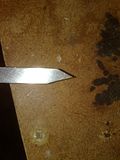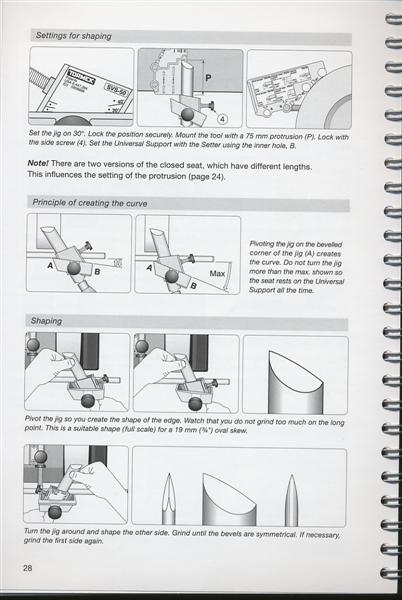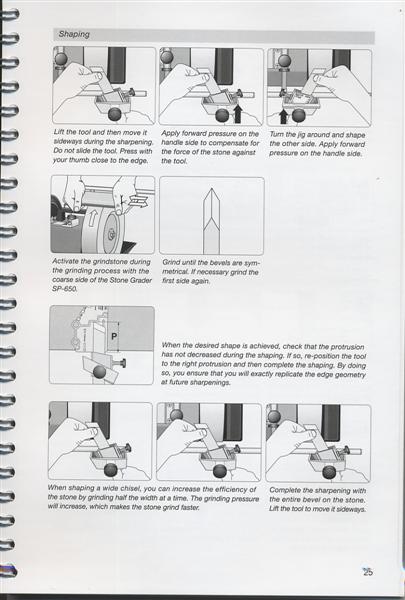devonwoody
Established Member
BMac":2h8f65vz said:50mm
Thanks, so how does the Sorby cope with wider plane irons?
Doesnt it mean that one side of a blade gets more touch or does the system cope?

BMac":2h8f65vz said:50mm
devonwoody":369qa51y said:When you are coming off the belt or wheel there must be a difference in pressure being applied to the blade by the operator.




Jenx":1lk3fa91 said:Miles... this is just a personal view, but I've stopped putting skews anywhere near an abraisive wheel now... its the only turning tool which I do this with, but its straight onto an oilstone for the skews with me... and they come off absolutely razor sharp.
Just an idea
cornucopia":3cldidxg said:hi miles- at the bash i did the majority of reshaping of your gouge on a dry grinder then i got the razors edge on the tormek which is where it excells-
the tormek can re shape slightly but overall it is best at restoreing the razor edge to an existing profile which has been previously made by the tormek-
the first time you do any tool on the tormek you will have a more long winded job- and possibly do some on the dry grinder first, depending on how much of a change is needed.
Oh I don't doubt the edge will be brilliant but frankly taking 2-4 evenings to get to it is stupid, I don't get that long in the garage. :evil: Hence I will be sorting a grinder out and doing the first pass on that and then sorting the final sharpness on the TormekPaul.j":3cldidxg said:Keep at it Miles the results will be worth it.
Interesting point - I did find that there was more "action" after the truing however I was doing it too many times for comfort. Given your view that the grading stone stuffs the squareness how do you use it and still have the benefit of the flat, square wheel?gidon":3cldidxg said:Don't use the black dressing stone after truing the wheel - you'll undo all the good work you've done with the diamond tool. I find the Tormek cuts pretty quickly after a fast past of the diamond truing too
Interesting - are you using some jig or free hand? The length of bevel that the Tormek setting is putting on the skew is pretty long. This picture shows the original length and the one that the standard settings on the Tormek are putting on:jenx":3cldidxg said:Miles... this is just a personal view, but I've stopped putting skews anywhere near an abraisive wheel now... its the only turning tool which I do this with, but its straight onto an oilstone for the skews with me... and they come off absolutely razor sharp

Jenx":1lv9w55q said:Pic looks more like a parting tool, Miles ?
For the Skew, I go free-hand... place the cutting edge on the stone, rock it back until it contacts the trailing edge of the bevel, then shaarpen, keeping both points in touch with the stone.
The actual bevel will be concave from initial profiling, so it only hits the stone at front and back contact-points... its real easy,
Then flip over for the other bevel..
For the parting tool. I use the grinder... just with a conventional platform type jig... it is the skew you mean, yes ?
Jenx":3bxcsy3i said:Pic looks more like a parting tool, Miles ?
For the parting tool. I use the grinder... just with a conventional platform type jig... it is the skew you mean, yes ?
wizer":k7d4nhej said:It's one of those chunky skews that Richard was talking about on my skew thread.
Jenx":ho6s0b1y said:Ah.. i get you.. you're showing it 'side-on'.
Its not particulary 'even' is it ?
I'm not certain that it;d absolutely have to be ....
but mine all are.
I'm guessing that might be a good place to start with it... even-ing up the two grinds, then going from there.
wizer":1xtewdd3 said:With the tormek, can you not just match the bevel angle, then hone? Or do you have to use their pre-set angles?
miles_hot":372a8wso said:...Oh, I'm positive you can match the angles etc however as I've never used a skew before I thought I'd go with the single recommended setting in the tormek book and see what that felt like...
Miles

